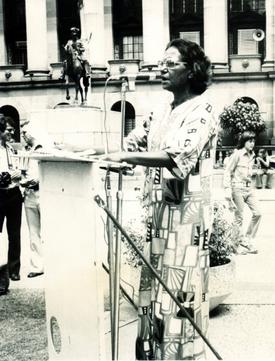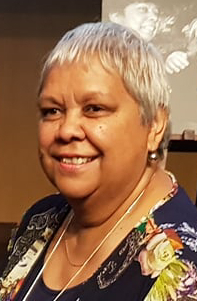Related Research Articles

Oodgeroo Noonuccal ( UUD-gə-roo NOO-nə-kəl; born Kathleen Jean Mary Ruska, later Kath Walker was an Aboriginal Australian political activist, artist and educator, who campaigned for Aboriginal rights. Noonuccal was best known for her poetry, and was the first Aboriginal Australian to publish a book of verse.
Fiona Foley is a contemporary Indigenous Australian artist from K'gari, Queensland. Foley is known for her activity as an academic, cultural and community leader and for co-founding the Boomalli Aboriginal Artists Co-operative.
Dorothy Napangardi was a Warlpiri speaking contemporary Indigenous Australian artist born in the Tanami Desert and who worked in Alice Springs.

Marcia Lynne Langton is an Aboriginal Australian writer and academic. As of 2022 she is the Redmond Barry Distinguished Professor at the Melbourne School of Population and Global Health, University of Melbourne. Langton is known for her activism in the Indigenous rights arena.

Samuel William Watson, also known as Sammy Watson Jnr, was an Aboriginal Australian activist from the 1970s, who in later life stood as a Socialist Alliance candidate. He is known for being a co-founder of the Australian Black Panther Party in 1971/2. Through work at the Brisbane Aboriginal Legal Service in the early 1990s, Watson was involved in implementing the findings of the Royal Commission into Aboriginal Deaths in Custody. From 2009 was deputy director at the Aboriginal and Torres Strait Islander Studies Unit at the University of Queensland.

Henrietta Marrie is a Gimuy Walubara Yidinji elder, an Australian Research Council Fellow and Honorary Professor with the University of Queensland.

Jacqueline Gail "Jackie" Huggins is an Aboriginal Australian author, historian, academic and advocate for the rights of Indigenous Australians. She is a Bidjara/Pitjara, Birri Gubba and Juru woman from Queensland.
Danie Mellor is an Australian artist who was the winner of 2009 National Aboriginal & Torres Strait Islander Art Award. Born in Mackay, Queensland, Mellor grew up in Scotland, Australia, and South Africa before undertaking tertiary studies at North Adelaide School of Art, the Australian National University (ANU) and Birmingham Institute of Art and Design. He then took up a post lecturing at Sydney College of the Arts. He works in different media including printmaking, drawing, painting, and sculpture. Considered a key figure in contemporary Indigenous Australian art, the dominant theme in Mellor's art is the relationship between Indigenous and non-Indigenous Australian cultures.

Bronwyn Bancroft is an Aboriginal Australian artist, administrator, book illustrator, and among the first three Australian fashion designers to show their work in Paris. She was born in Tenterfield, New South Wales, and trained in Canberra and Sydney.
Hetti Kemerre Perkins is an Aboriginal Australian art curator and writer. She is known for her work at the Art Gallery of New South Wales, where she was the senior curator of Aboriginal and Torres Strait Islander art at the gallery from around 1998 until 2011, and for many significant exhibitions and projects.

Daisy Elizabeth Marchisotti was an Australian social and political activist whose commitment to Indigenous rights saw her remain an active member of the political community up until her death in 1987. She is known for her communist affiliations and was an active member of the Communist Party of Australia.

The Quandamooka people are Aboriginal Australians who live around Moreton Bay in Southeastern Queensland. They are composed of three distinct tribes, the Nunukul, the Goenpul and the Ngugi, and they live primarily on Moreton and North Stradbroke Islands, that form the eastern side of the bay. Many were pushed out of their lands when the English colonial government established a penal colony near there in 1824. Each group has its own language. A number of local food sources are utilised by the tribes.
Aileen Moreton-Robinson is an Indigenous Australian academic, Indigenous feminist, author and activist for Indigenous rights. She is a Goenpul woman of the Quandamooka people from Minjerribah in Queensland. She completed a PhD at Griffith University in 1998, her thesis titled Talkin' up to the white woman: Indigenous women and feminism in Australia. The thesis was published as a book in 1999 and short-listed for the New South Wales Premier's Literary Awards and the Stanner Award. A 20th Anniversary Edition was released in 2020 by University of Queensland Press. Her 2015 monograph The White Possessive: Property, Power, and Indigenous Sovereignty was awarded the Native American and Indigenous Studies Association's (NAISA) prize in 2016.

Judy Watson is an Australian Waanyi multi-media artist who works in print-making, painting, video and installation. Her work often examines Indigenous Australian histories, and she has received a number of high-profile commissions for public spaces.
Jennifer Herd is an Australian Indigenous artist with family ties to the Mbar-barrum people of North Queensland. She is a founding member of the ProppaNOW artist collective, and taught at the Queensland College of Art in Brisbane, where she convened both the Bachelor of Fine Art and Contemporary Australian Indigenous Art. In 2003 she won the Queensland College of Art Graduate Students prize, the Theiss Art Prize, for her Masters of Visual Arts.
Brenda L. Croft is an Aboriginal Australian artist, curator, writer, and educator working across contemporary Indigenous and mainstream arts and cultural sectors. Croft was a founding member of the Boomalli Aboriginal Artists Cooperative in 1987.
Megan Cope is an Australian Aboriginal artist from the Quandamooka people of Stradbroke Island/Minjerribah. She is known for her sculptural installations, video art and paintings, in which she explores themes such as identity and colonialism. Cope is a member of the contemporary Indigenous art collective ProppaNOW in Brisbane.
Banduk Mamburra Wananamba Marika, known after her death as Dr B Marika, was an artist, printmaker and environmental activist from Arnhem Land, Northern Territory, Australia, who was dedicated to the development, recognition and preservation of Indigenous Australian art and culture. She uses her artwork to translate her ancestral stories through figures and motifs. She was one of the few Indigenous artists to specialize almost entirely in print making. She was the first Aboriginal person to serve on the National Gallery of Australia's board.
Caroline Lillian Archer was an Aboriginal Australian activist and telephonist.
Gail Mabo is an Australian visual artist who has had her work exhibited across Australia. She is the daughter of land rights campaigner Eddie Mabo and educator and activist Bonita Mabo. She was formerly a dancer and choreographer.
References
- ↑ AustLit Agent: Watson, Lilla
- ↑ "Etiquette for Activists by Michael F. Leonen - YES! Magazine". 7 August 2011. Archived from the original on 7 August 2011. Retrieved 1 December 2020.
- ↑ Reblog of report from Northland Poster
- ↑ "Aunty Lilla Watson". alumni.uq.edu.au. 19 November 2020. Retrieved 2 January 2022.